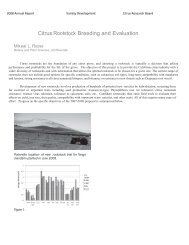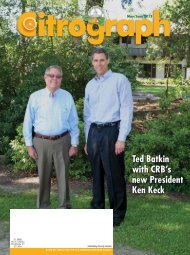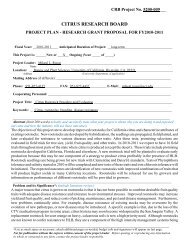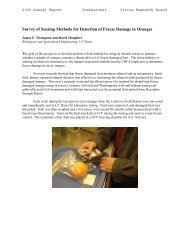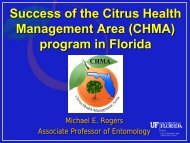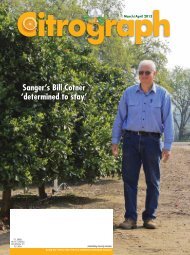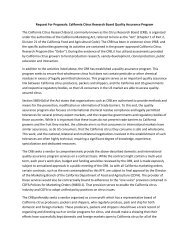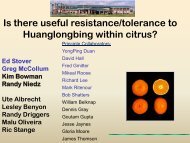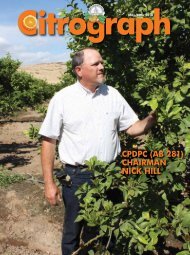Beth Grafton-Cardwell and her team at Lindcove - Citrus Research ...
Beth Grafton-Cardwell and her team at Lindcove - Citrus Research ...
Beth Grafton-Cardwell and her team at Lindcove - Citrus Research ...
You also want an ePaper? Increase the reach of your titles
YUMPU automatically turns print PDFs into web optimized ePapers that Google loves.
When Japan dropped its<br />
phytosanitary requirements<br />
for Fuller rose<br />
beetle (FRB) in the mid-1990s,<br />
interest in FRB control subsided.<br />
However, FRB is in the spotlight<br />
again as trading partners in Korea<br />
<strong>and</strong> Thail<strong>and</strong> have raised phytosanitary<br />
concerns about the possible<br />
movement of FRB eggs on fruit<br />
destined for those countries.<br />
Except for clogging sprinkler<br />
heads from time to time, FRB is not<br />
a major pest of California citrus, <strong>and</strong><br />
adult beetles rarely if ever make it<br />
into a packed carton for shipment.<br />
The primary concern is eggs, which<br />
are difficult to remove once laid<br />
under the calyx. Since it is difficult<br />
to remove or kill FRB eggs once<br />
they are laid, it is important to kill<br />
as many adults as possible before<br />
eggs can be laid.<br />
While Korea allows fumig<strong>at</strong>ion<br />
for FRB <strong>at</strong> the port of arrival, ot<strong>her</strong><br />
destin<strong>at</strong>ions such as Thail<strong>and</strong> refuse<br />
entry of fruit w<strong>her</strong>e FRB has been<br />
detected. With more markets raising<br />
barriers because of FRB, control<br />
of this pest is becoming more important.<br />
When fruit is denied entry<br />
in export markets, it must be sold<br />
in the domestic market. Since the<br />
domestic market is already wellsupplied,<br />
it is difficult to market<br />
more domestic fruit without reducing<br />
the price <strong>and</strong> in turn reducing<br />
grower prices.<br />
FRB control<br />
FRB has proved difficult to<br />
control because adults emerge from<br />
the soil every month of the year<br />
with peak emergence taking place<br />
over the July-October period. When<br />
adults emerge, they instinctively<br />
look for avenues to climb trees<br />
to lay eggs because they cannot<br />
fly. When foliage is touching the<br />
ground, t<strong>her</strong>e are many available<br />
avenues for adults to reach foliage<br />
20 Citrograph July/August 2011<br />
Renewed focus on<br />
Fuller rose beetle control<br />
An FRB pupa with two larvae.<br />
Leaf damage caused by Fuller rose beetle.<br />
Fuller rose beetle adult.<br />
Jim Cranney<br />
FRB eggs under the fruit button of citrus.<br />
All photos courtesy of UC St<strong>at</strong>ewide IPM Program,<br />
copyright 2000, Regents of the University of California.<br />
<strong>and</strong> fruit. Skirt pruning <strong>and</strong> removing<br />
weeds can minimize avenues for<br />
entry to the tree, so fewer adults<br />
reach the canopy to lay eggs.<br />
In addition to skirt pruning,<br />
the University of California is experimenting<br />
with trunk sprays, <strong>and</strong><br />
both cryolite <strong>and</strong> carbaryl can be<br />
effective as preharvest foliar sprays.<br />
To detect FRB, look for typical<br />
jagged p<strong>at</strong>terns of feeding on foliage<br />
<strong>and</strong> tap branches over a white<br />
cloth to dislodge the adults. They<br />
will drop <strong>and</strong> “play dead” so they<br />
are easy to spot against the white<br />
cloth.<br />
<strong>Research</strong> for new control<br />
measures<br />
With the emerging importance<br />
of FRB, UC Riverside’s Dr. Joseph<br />
Morse <strong>and</strong> the <strong>Lindcove</strong> <strong>Research</strong><br />
<strong>and</strong> Extension Center’s Dr. <strong>Beth</strong><br />
<strong>Grafton</strong>-<strong>Cardwell</strong> plan to evalu<strong>at</strong>e<br />
existing <strong>and</strong> new foliar pesticide<br />
tre<strong>at</strong>ments, how to make trunk<br />
sprays more effective, <strong>and</strong> whet<strong>her</strong><br />
Fidiobia citri (an egg parasitoid),<br />
will control FRB. The Agricultural<br />
<strong>Research</strong> Service’s Dr. Spencer<br />
Walse in Parlier plans to evalu<strong>at</strong>e<br />
fumigants th<strong>at</strong> could be used to kill<br />
FRB eggs.<br />
The goal is to find more <strong>and</strong> better<br />
ways to control FRB <strong>and</strong> keep<br />
export markets open. Meanwhile,<br />
growers are encouraged to evalu<strong>at</strong>e<br />
their groves for the presence of<br />
FRB <strong>and</strong> take steps to reduce the<br />
popul<strong>at</strong>ions.<br />
In closing, I would like to add a<br />
special note of appreci<strong>at</strong>ion to Dr.<br />
Morse for his invaluable input to<br />
this article. As many readers will<br />
recall, it was Morse who took the<br />
lead on FRB research when the<br />
pest first became an issue for California<br />
in the 1980s.<br />
Jim Cranney is President of the<br />
California <strong>Citrus</strong> Quality Council<br />
(CCQC). l




